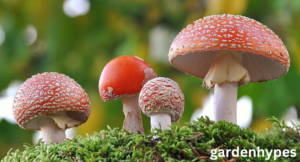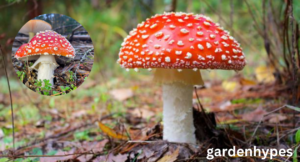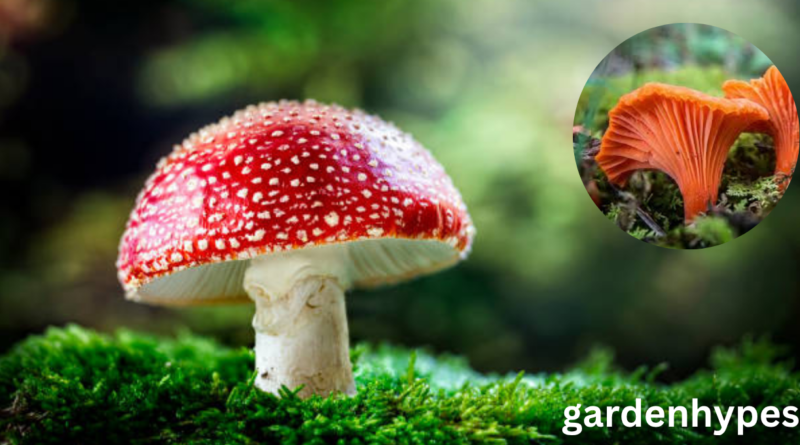Red Mushroom Identification A Simple Guide to Spotting Edible and Toxic Varieties
Red mushrooms are some of the most eye-catching and mysterious fungi you’ll come across in the wild. Whether you’re an amateur forager, a nature lover, or just someone who stumbled upon a vivid scarlet cap in the woods, it’s natural to be both fascinated and cautious. Many red mushrooms are toxic, some are even deadly, while others are perfectly safe and edible. So how do you tell them apart? This guide will walk you through red mushroom identification step by step—with real-world examples, field tips, and simple language anyone can understand.
click in link ugliest Flower
Introduction to Red Mushrooms
Why Red Mushrooms Attract Attention
Let’s be honest: red mushrooms look like they jumped straight out of a fairy tale. With their bright crimson caps, speckled tops, and often peculiar shapes, they’re hard to ignore. In fact, the famous red and white mushroom emoji (🍄) is modeled after the Amanita muscaria, one of the most iconic red mushrooms in the world.
This vivid color isn’t just for show—it’s often a biological warning. In nature, bright colors serve as a red flag (literally) to potential predators. It says, “Hey, I might be poisonous—don’t eat me!” It’s the same reason why some frogs, snakes, and insects are brightly colored. It’s called aposematism, and mushrooms do it, too.
But here’s the twist—not all red mushrooms are toxic. Some are edible and even prized for their flavor. That’s where it gets tricky. If you rely on color alone, you might end up misidentifying a safe mushroom as dangerous—or worse, mistake a deadly mushroom for something safe.
That’s why identification is so important. You need to look beyond the surface and understand what features really matter.
Importance of Proper Identification
Let’s be blunt: misidentifying mushrooms can kill you. There’s no gentle way to say it. Many toxic mushrooms closely resemble edible ones, and the red varieties are no exception.
Proper identification means looking at more than just color. You’ll need to examine the mushroom’s shape, size, gill structure, spore print, habitat, and even the time of year it appears. It’s not rocket science, but it does require patience and careful observation.
For foragers, knowing your mushrooms is essential. But even if you don’t plan to eat them, being able to identify red mushrooms is a fun and educational way to connect with nature. Plus, it’s a great skill to impress your hiking buddies!
So grab your notebook, camera, or field guide—we’re going mushroom hunting.
Understanding Mushroom Anatomy
Cap, Gills, Stem, and Spores Explained
To identify any mushroom—red or otherwise—you need to know its basic parts. Here’s a quick breakdown of mushroom anatomy:
- Cap (Pileus): The top of the mushroom. This is often the first thing you notice, especially in red mushrooms. Caps can be smooth, warty, slimy, or dry. Their shape can also vary—convex, flat, or even funnel-shaped.
- Gills (Lamellae): Located underneath the cap, these are the thin, blade-like structures where spores are produced. Pay attention to their color, spacing, and whether they’re attached to the stem.
- Stem (Stipe): The stalk that supports the cap. Stems can be thick, thin, hollow, solid, ringed, or bare.
- Spores: Tiny reproductive cells released by the gills. You can do a spore print by placing the cap gill-side-down on a white or black piece of paper and leaving it overnight. The color of the spore print is often key to identification.

Each of these features offers clues to a mushroom’s identity. Think of them like fingerprints—no two mushrooms have the exact same combo.
click in link ugliest Flower
Red Coloration—What It Means in Nature
When you see red in nature, your instincts might say “danger”—and that’s not a bad instinct to have when it comes to mushrooms. Bright red caps often serve as a deterrent to predators (including humans). Many red mushrooms contain toxins like muscarine, ibotenic acid, or even deadly amatoxins.
However, red isn’t a guaranteed sign of toxicity. Some waxcap mushrooms (genus Hygrocybe) are a brilliant red and completely harmless. Others, like Russula emetica, are red and mildly toxic, causing stomach upset. Then you have Amanita muscaria, which is red, beautiful, psychoactive, and toxic—but rarely fatal.
In other words, red is a warning sign—but it’s not the whole story. Always investigate further.
Common Types of Red Mushrooms
Amanita Muscaria (Fly Agaric)
Arguably the most famous mushroom in the world, Amanita muscaria looks like something out of a dream—or a nightmare. With its bright red cap dotted with white warts, it’s the textbook image of a toadstool.
- Cap: Bright red, 5–20 cm wide, with white or yellowish warts.
- Gills: White, free from the stem.
- Stem: White with a skirt-like ring, and a bulbous base with a cup (volva).
- Spore Print: White.
- Toxicity: Contains ibotenic acid and muscimol. Causes hallucinations, nausea, confusion.
Despite its reputation, Amanita muscaria is not typically deadly, but it is toxic and should not be eaten raw. In some cultures, it’s used for its psychoactive properties—but this is not something you should experiment with casually. Always treat it with caution.
Russula emetica (The Sickener)
This one lives up to its name. While its vivid red cap may look appealing, Russula emetica is known for causing gastrointestinal distress—hence the name “The Sickener.”
- Cap: Bright red, round and glossy, often with a depressed center.
- Gills: White, closely spaced, brittle.
- Stem: White, fragile.
- Spore Print: White to pale cream.
- Toxicity: Causes vomiting and diarrhea, but not deadly.
This is a classic “looks can be deceiving” mushroom. You’ll often find it near pine trees, and it may resemble edible Russulas—another reason why proper ID is essential.
click in link ugliest Flower

faqs
FAQ 1: Are all red mushrooms poisonous?
No, not all red mushrooms are poisonous. While many red mushrooms use bright coloring as a warning signal (like Amanita muscaria), others—such as some waxcaps (Hygrocybe spp.)—are harmless. However, red is often a sign of toxicity in nature, so it’s crucial not to rely solely on color when identifying mushrooms. Always use multiple characteristics—like gills, habitat, and spore print—to make an accurate ID.
FAQ 2: What is the easiest way to tell if a red mushroom is edible?
There is no “easy” way. The only safe approach is to study and cross-reference its features with a reliable field guide or consult with a local mycologist. Key features include the cap’s texture and shape, the gill attachment, the color of the spore print, the presence of a volva or ring, and where the mushroom is growing. Never taste or eat a mushroom unless you are 100% sure of its identity.
FAQ 3: Can I touch red mushrooms with my bare hands?
Yes, touching red mushrooms is generally safe. The toxins found in mushrooms usually need to be ingested to be harmful. However, after handling any wild mushroom, it’s a good idea to wash your hands—especially before eating or touching your face.
FAQ 4: Where can I learn mushroom identification safely?
Start with local foraging or mycology groups, which often host walks and workshops. Use field guides with clear photos and detailed descriptions. Online forums, apps like iNaturalist, and YouTube channels dedicated to mushroom hunting can also be helpful—but always cross-reference multiple sources to avoid dangerous misidentifications.
FAQ 5: What should I do if I accidentally eat a red mushroom?
If you or someone else eats a red mushroom—especially one that hasn’t been positively identified—seek medical help immediately. Call your local poison control center or go to the nearest emergency room. If possible, bring a sample of the mushroom with you for proper identification. Early medical intervention can be life-saving in mushroom poisoning cases.
